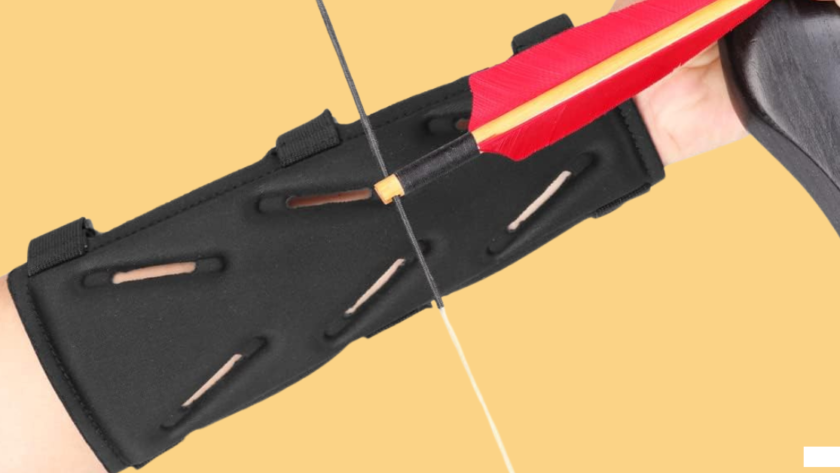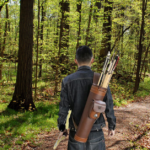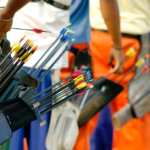Introduction
I never thought I’d become so passionate about archery arm guards. When I first started shooting, I scoffed at the idea of needing extra protection.
I’d proudly display my bruises like battle scars.
But then came that fateful day at the range when a particularly nasty string slap left me wincing for weeks. That’s when I realized: arm guards are essential for enhancing your entire archery experience.
Arm guards are more than just simple pieces of leather or plastic strapped to your forearm. They’re a crucial interface between you and your bow, playing a vital role in your shooting technique, comfort, and even accuracy.
The right arm guard gives you the confidence to focus on your form without fear of injury, while the wrong one can hinder your performance and even lead to bad habits.
The Evolution of Arm Guards
Archery equipment has a rich history dating back thousands of years. From the elaborately decorated bracers of medieval archers to the high-tech composite guards used in modern competitions, arm guards have evolved alongside the sport itself.
Ancient Origins
Archaeological evidence suggests that arm guards have been used since the Neolithic period. Early hunters and warriors recognized the need to protect their forearms from the snap of the bowstring.
These primitive guards were often made from leather, bone, or even stone.
Medieval Craftsmanship
During the Middle Ages, arm guards became more than just protective gear. They were often ornately decorated, serving as status symbols for skilled archers.
Craftsmen would embellish leather bracers with intricate designs, precious metals, and even jewels for nobility.
Industrial Revolution and Mass Production
The Industrial Revolution brought about new manufacturing techniques, making arm guards more accessible to the average archer. Mass-produced leather and early synthetic materials became common, offering affordable protection to a wider audience.
Modern Innovations
Today’s arm guards incorporate cutting-edge materials and design principles. We now have:
- Lightweight, high-strength polymers
- Moisture-wicking fabrics
- Ergonomically designed shapes for most comfort
- Adjustable straps for a custom fit
- Built-in vibration dampening technology
Understanding the Biomechanics of Archery
To appreciate the importance of a good arm guard, we need to understand what happens during a shot. As you draw the string back, your forearm naturally rotates inward.
This rotation can bring your arm into the path of the string upon release, leading to that dreaded string slap.
A well-designed arm guard creates a smooth surface for the string to glide past, redirecting that energy and protecting your skin. But protection is just the beginning. Modern arm guards are engineered to enhance performance in subtle ways:
- Aerodynamic designs reduce air resistance during outdoor shoots
- Moisture-wicking materials keep your arm dry and comfortable during long practice sessions
- Vibration dampening properties contribute to a quieter, more stable shot
Choosing the Perfect Arm Guard
Selecting the right arm guard is a highly personal process. You need to consider your shooting style, bow type, and even the shape of your arm.
A recurve shooter might prefer a longer guard that extends further up the forearm, while a compound archer might opt for a more compact design that allows for greater flexibility.
Assessing Your Needs
Before you start shopping, take some time to think about:
- Your bow type: Recurve, compound, or traditional?
- Shooting frequency: How often do you practice or compete?
- Specific issues: Have you experienced persistent bruising in a particular spot?
- Environment: Do you primarily shoot indoors, outdoors, or both?
Measurements Matter
Accurate measurements are crucial for finding the right fit:
- Forearm length: Measure from your elbow crease to your wrist
- Forearm circumference: Measure around the widest part of your forearm
These measurements will help you choose the right size and coverage area.
Material Considerations
Different materials offer various benefits:
- Leather: Offers a classic look and molds to your arm over time. It’s durable but can be heavier and less breathable than synthetic options.
- Synthetic materials: Often more affordable and easier to clean. They can be lightweight and offer good moisture-wicking properties.
- High-tech composites: Provide most protection with minimal weight. These are often favored by competitive archers.
Try Before You Buy
If possible, visit an archery shop to try on different styles. Pay attention to:
- How the guard feels during your draw and release
- Whether it restricts your movement in any way
- The ease of putting it on and taking it off
Proper Adjustment is Key
Most arm guards have some form of adjustability. Take the time to get it just right:
- The guard should be snug enough to stay in place but not so tight that it restricts blood flow
- Position it so that it covers the area where string slap typically occurs
- Make sure it doesn’t interfere with your clothing or other equipment
Breaking In Your New Guard
Wear your new arm guard for a few practice sessions to allow it to conform to your arm and shooting style. This is especially important for leather guards, which will soften and mold to your arm over time.
Common Pitfalls to Avoid
One potential pitfall to watch out for is over-reliance on your arm guard. While it’s there to protect you, it shouldn’t become a psychological crutch.
I’ve seen archers develop a fear of shooting without their guard, which can be detrimental to their overall technique.
To avoid this, I recommend occasionally practicing without the guard (in a controlled, safe environment) to maintain awareness of your form. This will help you:
- Stay mindful of your arm position
- Identify any form issues that the guard might be masking
- Build confidence in your shooting ability
Another mistake I often see is treating the arm guard as a substitute for proper form. While a good guard can compensate for some technique issues, it’s crucial to view it as a tool for refining your form, not masking problems.
Adapting Your Arm Guard Use
Different archery scenarios call for different approaches to arm guard use:
Indoor Target Practice
For indoor shooting, you might prefer a lighter, more breathable option. Look for:
- Slim profiles that won’t interfere with tight-fitting indoor shooting attire
- Moisture-wicking materials to keep you comfortable during long practice sessions
- Guards with minimal bulk to reduce any potential impact on your shot
Outdoor 3D Courses
When shooting outdoors, especially on 3D courses, consider:
- More rugged guards that can withstand brushes with vegetation
- Wider coverage to protect against varying angles of string contact
- Weather-resistant materials that won’t degrade with exposure to the elements
Hunting Scenarios
For bowhunting, your arm guard needs to blend function with stealth:
- Look for guards with camouflage patterns that match your hunting attire
- Consider noise-reducing features to minimize any sound during movement
- Opt for scent-free materials or those that can be easily treated to reduce odor
Evolving with Your Archery Skills
As you progress in your archery journey, your relationship with your arm guard will likely change. What worked for you as a beginner might not be ideal as you refine your technique.
Don’t be afraid to experiment with different styles and materials as your skills advance.
Some top-level archers even use custom-made guards tailored to their exact specifications. These might include:
- Precisely shaped contours to match the archer’s arm
- Specialized materials chosen for their unique properties
- Integrated features like arrow rests or sight mounts
Advanced Arm Guard Techniques
To truly master the use of your arm guard, try this exercise:
- Set up a target at your usual practice distance
- Take 10 shots with your arm guard, focusing on your form and the feeling of the string passing your arm
- Carefully take 10 shots without the guard (only if you can do so safely)
- Pay close attention to any differences in your technique or mental approach
This comparison can reveal subtle ways your arm guard might be influencing your shot. You might notice:
- Changes in your arm position
- Differences in your release technique
- Variations in your follow-through
Use these insights to fine-tune both your form and your choice of arm guard.
Maintenance and Care
Proper care of your arm guard will confirm it continues to perform well and last longer:
Leather Guards
- Clean with a damp cloth and mild soap
- Apply leather conditioner periodically to prevent cracking
- Store in a cool, dry place to prevent mold growth
Synthetic Guards
- Wash with mild detergent and warm water
- Air dry completely before storing
- Avoid exposure to extreme heat, which can warp some materials
Composite Guards
- Wipe clean with a damp cloth
- Check regularly for any cracks or signs of wear
- Store flat to prevent warping
The Psychology of Protection
The right arm guard does more than just protect your skin – it can have a significant impact on your mental game. Knowing you’re protected allows you to focus fully on your shot without the nagging worry of potential injury.
This confidence can lead to:
- More relaxed shooting form
- Increased willingness to practice for longer periods
- Greater enjoyment of the sport overall
However, it’s important to strike a balance. Your arm guard should enhance your shooting experience, not become a crutch that you can’t shoot without.
Arm Guards for Different Archer Types
Youth Archers
Young archers have unique needs when it comes to arm guards:
- Look for adjustable options that can grow with the child
- Choose lightweight materials that won’t fatigue young arms
- Consider fun colors or designs to keep them engaged in the sport
Women Archers
Women often have different arm shapes and sizes compared to men:
- Seek out guards designed specifically for women’s physiology
- Look for options with a greater range of size adjustability
- Consider guards that offer protection higher up the arm to account for different draw lengths
Paralympic Archers
Archers with disabilities may need specialized arm guards:
- Some may need guards that can be easily put on and removed with limited mobility
- Others might benefit from guards integrated into other adaptive equipment
- Custom-made options are often the best choice for unique needs
The Future of Arm Guards
As archery technology continues to advance, we can expect to see some exciting developments in arm guard design:
- Smart materials that adapt to body heat and movement
- Integrated sensors that provide feedback on form and technique
- 3D-printed custom guards tailored to individual arm shapes
- Biodegradable options for environmentally conscious archers
Arm Guards in Competition
Different archery organizations have varying rules regarding arm guards in competition. Always check the specific regulations for your event.
Generally:
- Most organizations allow arm guards in competition
- Some traditional archery events may have restrictions on materials or designs
- Certain 3D archery competitions might limit the size or coverage of guards
DIY Arm Guards
For the crafty archer, making your own arm guard can be a rewarding project:
- Choose a durable material like leather or heavy canvas
- Create a pattern based on your arm measurements
- Cut out the material and any padding you want to include
- Sew or rivet the pieces together
- Add adjustable straps for a custom fit
Custom-made guards allow you to tailor every aspect to your preferences, from the exact coverage area to the placement of padding.
Arm Guards and Archery Culture
Arm guards have played a significant role in archery culture throughout history:
- In some traditions, receiving your first arm guard marks a rite of passage for young archers
- Historical reenactment groups often recreate period-accurate arm guards as part of their costumes
- Some archers view their arm guards as lucky charms or talismans for competition
Integrating Your Arm Guard into Your Shooting Routine
To get the most out of your arm guard, incorporate it thoughtfully into your shooting routine:
- Put on your guard as part of your pre-shot checklist
- Take a moment to adjust it properly before beginning your practice session
- Periodically check it’s position throughout your shooting to confirm it hasn’t shifted
- Remove and inspect it after each session, noting any wear patterns that might show form issues
The Environmental Impact of Arm Guards
As archers, we have a responsibility to consider the environmental impact of our equipment choices:
- Look for arm guards made from sustainable or recycled materials
- Choose durable options that won’t need frequent replacement
- Consider the end-of-life disposal of your guard when making a purchase
Some manufacturers are now offering biodegradable or easily recyclable arm guards, helping to reduce the sport’s environmental footprint.
Arm Guards for Other Sports
The principles behind archery arm guards have applications in other sports and activities:
- Fencing: Arm guards protect against blade strikes
- Cricket: Batsmen use arm guards to protect against fast bowls
- Lacrosse: Players wear arm guards to cushion checks from opponents’ sticks
Understanding how arm guards are used in these sports can provide insights for archery guard design and use.
The Role of Technology in Arm Guard Design
Modern arm guards benefit from advanced design and manufacturing techniques:
- Computer-aided design (CAD) allows for precise shaping and ergonomic contouring
- 3D printing enables rapid prototyping and custom-fit guards
- Advanced materials science has led to guards that are stronger, lighter, and more comfortable than ever before
Arm Guards and Archery Technique
A well-chosen arm guard can actually help improve your shooting technique:
- It can encourage proper arm rotation during the draw
- The guard’s edge can serve as a reference point for consistent arm positioning
- Some guards have built-in alignment markers to help with form
The Economics of Arm Guards
The arm guard market is a significant part of the archery industry:
- Entry-level guards can cost as little as $10
- High-end, custom-made guards can run into hundreds of dollars
- The global archery equipment market, including arm guards, is projected to grow significantly in the coming years
Arm Guards in Popular Culture
Archery arm guards have made appearances in various forms of media:
- Fantasy literature often describes ornate, magical bracers
- Movies and TV shows featuring archers typically showcase stylized arm guards
- Video games allow players to customize their character’s arm guards for both function and aesthetics
These portrayals, while not always accurate, have helped raise awareness of arm guards among non-archers.
Conclusion
Arm guards are an essential piece of archery equipment that offer protection, enhance performance, and can even improve technique. By understanding the nuances of arm guard selection, use, and maintenance, you can take your archery experience to the next level.
Remember, the perfect arm guard is out there waiting for you. It might take some experimentation to find it, but the payoff in comfort, confidence, and improved shooting is well worth the effort.
Key Takeaways
- Choose an arm guard based on your specific needs, bow type, and shooting style
- Proper fit and adjustment are crucial for most benefit
- Use your arm guard as a means to improve form, not mask poor technique
- Experiment with different styles as your skills progress
- Regular maintenance will extend the life of your arm guard
- Consider the environmental impact of your arm guard choices
- Don’t be afraid to invest in a quality guard – your forearm will thank you!
People Also Asked
What is the purpose of an arm guard in archery?
An arm guard in archery protects the inner forearm from being struck by the bowstring upon release. It also helps reduce friction between the string and clothing, potentially improving shot consistency.
How tight should an archery arm guard be?
An archery arm guard should be snug enough to stay in place during shooting but not so tight that it restricts blood flow or causes discomfort. You should be able to fit one finger between the guard and your arm.
Can you shoot a bow without an arm guard?
While it’s possible to shoot a bow without an arm guard, it’s not recommended, especially for beginners. Shooting without a guard increases the risk of painful string slap and can lead to inconsistent shooting because of flinching.
What material is best for archery arm guards?
The best material for archery arm guards depends on personal preference and shooting conditions. Leather is durable and molds to your arm over time, while synthetic materials are often lighter and easier to clean.
High-tech composites offer most protection with minimal weight.
How long do archery arm guards last?
The lifespan of an archery arm guard varies depending on the material, frequency of use, and care. A well-maintained leather guard can last several years, while synthetic guards might need replacement every 1-2 years with regular use.
Are arm guards necessary for compound bows?
While compound bows generally have a lower risk of string slap because of their design, many archers still prefer to use arm guards. They provide peace of mind and can be particularly useful when shooting in cold weather with bulky clothing.
How do I measure for an archery arm guard?
To measure for an archery arm guard, measure the length from your wrist to about 2-3 inches below your elbow. Also measure the circumference of your forearm at it’s widest point.
These measurements will help you choose the right size guard.
Can arm guards improve archery accuracy?
While arm guards don’t directly improve accuracy, they can contribute to better shooting by allowing archers to focus on their form without fear of injury. Some guards also feature alignment markers that can help with consistent arm positioning.
Are there different arm guards for recurve and compound bows?
While many arm guards can be used with both recurve and compound bows, some archers prefer longer guards for recurve bows and shorter, more flexible guards for compound bows. The choice often comes down to personal preference and shooting style.
How do I clean my archery arm guard?
Cleaning methods vary depending on the material. Leather guards can be wiped with a damp cloth and treated with leather conditioner.
Synthetic guards can usually be washed with mild soap and water.
Always check the manufacturer’s care instructions for specific guidance.



